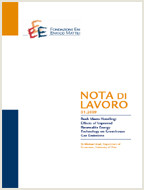The Conservation versus Production Trade-off: Does Livestock Intensification Increase Deforestation? The Case of the Brazilian Amazon

Data
06.03.2015
06.03.2015
Autori
Petterson Molina Vale (London School of Economics and Political Sciences)
Codice JEL
Q53, Q150
Q53, Q150
Parole chiave:
Amazon, Rebound Effect, Intensification, Deforestation, Land Use, Cattle Ranching
Amazon, Rebound Effect, Intensification, Deforestation, Land Use, Cattle Ranching
Publisher
Climate Change and Sustainable Development
Climate Change and Sustainable Development
Editor
Carlo Carraro
Carlo Carraro
More cattle, less deforestation? Land use intensification in the Amazon is an unexpected phenomenon. Theories of hollow frontier, speculative behaviour and boom-bust all share the prediction that livestock production will remain largely extensive. Yet between 1996 and 2006 productivity of cattle grew by an astounding 57.5% in the average Amazon municipality. Does rising land productivity of cattle increase deforestation? I use secondary data and spatial econometrics to look for evidence of a positive relation between cattle intensification and deforestation (‘rebound effect’). The reduced-form model I employ is based on a spatial econometric specification by Arima et al. (2011) and uses panel data at the municipality-level. I show that mounting productivity in consolidated areas has been associated with lower deforestation both in frontier and consolidated municipalities. This suggests that any process of out-migration spurred by the rising productivity is insufficient to have a positive impact on deforestation.
***
Suggested citation: Molina Vale, P., (2015), ‘The Conservation versus Production Trade-off: Does Livestock Intensification Increase Deforestation? The Case of the Brazilian Amazon’, Nota di Lavoro 20.2015, Milan, Italy: Fondazione Eni Enrico Mattei.
